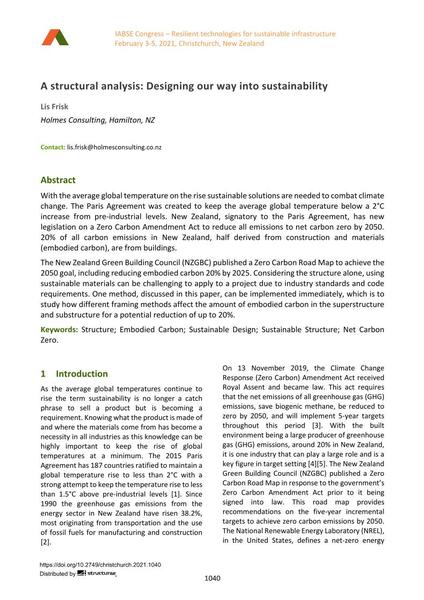A structural analysis: Designing our way into sustainability

|
|
|||||||||||
Bibliographic Details
| Author(s): |
Lis Frisk
(Holmes Consulting, Hamilton, NZ)
|
||||
|---|---|---|---|---|---|
| Medium: | conference paper | ||||
| Language(s): | English | ||||
| Conference: | IABSE Congress: Resilient technologies for sustainable infrastructure, Christchurch, New Zealand, 3-5 February 2021 | ||||
| Published in: | IABSE Congress Christchurch 2020 | ||||
|
|||||
| Page(s): | 1040-1047 | ||||
| Total no. of pages: | 8 | ||||
| DOI: | 10.2749/christchurch.2021.1040 | ||||
| Abstract: |
With the average global temperature on the rise sustainable solutions are needed to combat climate change. The Paris Agreement was created to keep the average global temperature below a 2°C increase from pre-industrial levels. New Zealand, signatory to the Paris Agreement, has new legislation on a Zero Carbon Amendment Act to reduce all emissions to net carbon zero by 2050. 20% of all carbon emissions in New Zealand, half derived from construction and materials (embodied carbon), are from buildings. The New Zealand Green Building Council (NZGBC) published a Zero Carbon Road Map to achieve the 2050 goal, including reducing embodied carbon 20% by 2025. Considering the structure alone, using sustainable materials can be challenging to apply to a project due to industry standards and code requirements. One method, discussed in this paper, can be implemented immediately, which is to study how different framing methods affect the amount of embodied carbon in the superstructure and substructure for a potential reduction of up to 20%. |
||||
| Keywords: |
structure sustainable design embodied carbon Sustainable Structure Net Carbon Zero
|
||||
